Barak Updates
In the Lap of Nature, writes Dr. Himabrata Das

Nov. 26: Nature researchers Pratik Das from IISc Bangalore and Salma Sultana Barbhuiya,who works with WWF India on human-elephant conflicts in Northeast India spoke to way2barak on their recent visit to the Barak Valley where they ventured into the wilderness with an enthusiastic bunch of students from various departments of Gurucharan College accompanied by their faculty member Dr Debipreeta Dutta Gupta. Dr. Himabrata Das spoke with them on behalf of way2barak.
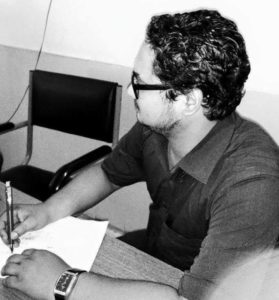
“My first nature walk was in Guwahati after which bird-watching became my hobby. We do not have this culture in Silchar mainly because of lack of awareness as well as initiative. Someone who is aware of such activities has to take the responsibility and pass the knowledge cum experience to others. Also, people do not realise the importance of citizen science, “says Salma Sultana Barbhuiya.
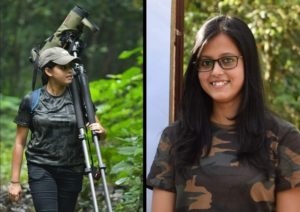 “Barak Valley because of its bio-geography and climatic condition is blessed with unique biodiversity. It has everything from forests to water bodies. Residents of the town do not know that there is a (fast vanishing) lake in Rongpur. So,as wildlife biologists, we felt that it would be a good way to begin. People will be able to connect more with nature as a result. They will understand that there are many other life forms that they share their surroundings with.It would drive engagement of people in the conservation of biodiversity awareness. They can contribute in their own way-writing, art, photography, research and even politics. They might fall in love……”,says a passionate Salma. On what youngsters can do to learn more about nature, she adds.”
“Barak Valley because of its bio-geography and climatic condition is blessed with unique biodiversity. It has everything from forests to water bodies. Residents of the town do not know that there is a (fast vanishing) lake in Rongpur. So,as wildlife biologists, we felt that it would be a good way to begin. People will be able to connect more with nature as a result. They will understand that there are many other life forms that they share their surroundings with.It would drive engagement of people in the conservation of biodiversity awareness. They can contribute in their own way-writing, art, photography, research and even politics. They might fall in love……”,says a passionate Salma. On what youngsters can do to learn more about nature, she adds.”

To learn about nature, it is necessary to get out of our homes and get into nature- it’s an amazing world out there. We have to understand that we are part of a larger ecosystem that we share with others. Parents first of all need to teach children to be respectful of all life forms (even the smallest ones) and then teach them to be responsible for their actions. We’ve already seen the power of a microscopic virus. Salma signs off by sharing the different types of conservation methods that can be implemented to protect such small fragmented forests. “Proper research and documentation is must because the stories need to be told. Issues like habitat degradation, biodiversity loss and human-wildlife conflicts need to be brought into popular discourse. We should engage people from all walks of life in conservation and ecological restoration.It’s all connected and our future will pay the price for our mistakes.”
 On what drives him towards the nature walks Pratik states, “My inspiration are the few youths of the Barak Valley themselves. I can see growing concern in the upcoming generation & also lack of knowledge in them. Everyone knows deforestation, climate change, habitat loss, pollution etc which are typical classroom stuff. But they don’t know what’s around them and what is changing and what they are losing. Relative to developed regions, Barak Valley has a lot more natural wealth to explore, observe and enjoy. And only when you connect with nature will you value it in the truest sense. Only when you value will you protect and preserve.”
On what drives him towards the nature walks Pratik states, “My inspiration are the few youths of the Barak Valley themselves. I can see growing concern in the upcoming generation & also lack of knowledge in them. Everyone knows deforestation, climate change, habitat loss, pollution etc which are typical classroom stuff. But they don’t know what’s around them and what is changing and what they are losing. Relative to developed regions, Barak Valley has a lot more natural wealth to explore, observe and enjoy. And only when you connect with nature will you value it in the truest sense. Only when you value will you protect and preserve.”
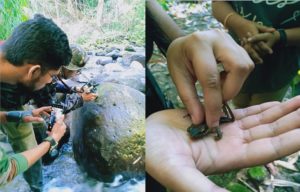 Pratik added, “I am amazed at how youngsters rebelled ferociously for Arey forest in Mumbai and saved it! Arey was about to be turned into a metro car shed. Arey is not even a protected area or a reserve forest (though it did fall under eco-sensitive zone). Sadly we could not even save our Gandhi Bag which is probably on its way to being turned into an amusement park right in the middle of our town. My inspiration is lack of awareness about importance of nature and its conservation in the northeast. The best way to do that is to reconnect people with nature, in person.”
Pratik added, “I am amazed at how youngsters rebelled ferociously for Arey forest in Mumbai and saved it! Arey was about to be turned into a metro car shed. Arey is not even a protected area or a reserve forest (though it did fall under eco-sensitive zone). Sadly we could not even save our Gandhi Bag which is probably on its way to being turned into an amusement park right in the middle of our town. My inspiration is lack of awareness about importance of nature and its conservation in the northeast. The best way to do that is to reconnect people with nature, in person.”
 On the outcome of such nature walks, Pratik adds, “Mass awareness and an ecological perspective leading to informed best decisions. … Nature walk is all about nature education. We conducted 6 nature walks which isn’t enough to make a significant difference. But me and Salma can’t continue throughout. We are currently based outside Barak Valley. We hope the participants will continue this initiative and expand the newly formed community. Its extremely important to take nature education to villagers and tribal population in forest fringes. These people continuously interact with the wild, hence an important stakeholder in conservation. The passionate wildlife researcher has these words to offer to youngsters as regards increasing their interest towards nature.”
On the outcome of such nature walks, Pratik adds, “Mass awareness and an ecological perspective leading to informed best decisions. … Nature walk is all about nature education. We conducted 6 nature walks which isn’t enough to make a significant difference. But me and Salma can’t continue throughout. We are currently based outside Barak Valley. We hope the participants will continue this initiative and expand the newly formed community. Its extremely important to take nature education to villagers and tribal population in forest fringes. These people continuously interact with the wild, hence an important stakeholder in conservation. The passionate wildlife researcher has these words to offer to youngsters as regards increasing their interest towards nature.”
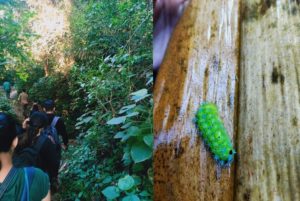 A camera (or phone camera), a note book and a pen/ pencil, is all one needs. Most of us think there is nothing outdoors but have you really looked for it? One doesn’t have to go to protected areas or reserve forests to experience nature. Nature is right where you are. There are so many interesting things around you just need to search… Birding started as a hobby and now its kind of a sport! Kerela holds the maximum number of birders. People go crazy trying to increase the checklist of birds spotted. I never understood that craze- its just a bird! Till I went out by myself alone. Spotting a bird itself is difficult let alone take a photo or register plumage patterns. Later identifying using a field guide is a different ball game. One has to be stealthy fast and patient at the same time. So much fun, quipped Pratik.
A camera (or phone camera), a note book and a pen/ pencil, is all one needs. Most of us think there is nothing outdoors but have you really looked for it? One doesn’t have to go to protected areas or reserve forests to experience nature. Nature is right where you are. There are so many interesting things around you just need to search… Birding started as a hobby and now its kind of a sport! Kerela holds the maximum number of birders. People go crazy trying to increase the checklist of birds spotted. I never understood that craze- its just a bird! Till I went out by myself alone. Spotting a bird itself is difficult let alone take a photo or register plumage patterns. Later identifying using a field guide is a different ball game. One has to be stealthy fast and patient at the same time. So much fun, quipped Pratik.
 Parents should encourage youngsters/children to watch nature documentaries. Take them out to their villages. Know how paddy is cultivated, how vegetables are grown. Look for caterpillars & butterflies in those. Go out for night stroll. Listen to owls and chirrups of crickets. Look for them! Bring back the buffalo/cattle home. I encourage students to start reading popular science books. At least start replacing fiction with non-fiction. Social media and PUBG with books. These outings and nature walks not just enhance knowledge or science but also maintains good mental health.
Parents should encourage youngsters/children to watch nature documentaries. Take them out to their villages. Know how paddy is cultivated, how vegetables are grown. Look for caterpillars & butterflies in those. Go out for night stroll. Listen to owls and chirrups of crickets. Look for them! Bring back the buffalo/cattle home. I encourage students to start reading popular science books. At least start replacing fiction with non-fiction. Social media and PUBG with books. These outings and nature walks not just enhance knowledge or science but also maintains good mental health.
 There is no shortage of resource persons in Barak Valley who are well versed in field. I request PhD students, professors and nature enthusiasts to join this initiative and dissipate their knowledge to common people. Science/ knowledge is for all. Nature walk is for all, not just students. We started with flora, fauna and environmental issues. Imagine how interesting will it be to learn about meandering rivers and rocks in the day, and search constellations and planets at night!”, Pratik states sharing his vision about how different stakeholders need to contribute to conserve nature.
There is no shortage of resource persons in Barak Valley who are well versed in field. I request PhD students, professors and nature enthusiasts to join this initiative and dissipate their knowledge to common people. Science/ knowledge is for all. Nature walk is for all, not just students. We started with flora, fauna and environmental issues. Imagine how interesting will it be to learn about meandering rivers and rocks in the day, and search constellations and planets at night!”, Pratik states sharing his vision about how different stakeholders need to contribute to conserve nature.
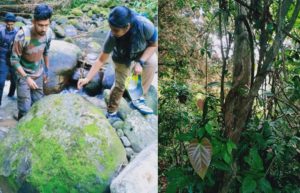 Pratik finishes with an elaborate account of the wildlife in our region. “Forested landscape in Barak Valley mainly implies 16 reserve forests (RF). Barail Wildlife Sanctuary (WS) consists of two among them, Barail and North Cachar RF. They are protected by law…. Apart from these, there are many fragmented forests in Barak Valley occupying several hillocks which don’t receive any protection. Many of them might harbour good wildlife. One such range of hillocks is in Rengti, near Budhurail. Rengti holds quite a lot of wild plants reminiscent of its previous connections with western reserved forests. Rengti is currently undergoing massive earth excavation. One group of hillocks shelters a >25 years old traditional roost of Indian Flying fox (a fruit bat). Though bats have been disproportionately villainized, their ecological function can never be underestimated. In layman’s term, they make and maintain forests. This species is declining and if not monitored, may suddenly face the fate of vultures (when did you last see a vulture?). In that very hillock, I saw a rare monkey called the pig tailed macaque (IUCN status- vulnerable)!”
Pratik finishes with an elaborate account of the wildlife in our region. “Forested landscape in Barak Valley mainly implies 16 reserve forests (RF). Barail Wildlife Sanctuary (WS) consists of two among them, Barail and North Cachar RF. They are protected by law…. Apart from these, there are many fragmented forests in Barak Valley occupying several hillocks which don’t receive any protection. Many of them might harbour good wildlife. One such range of hillocks is in Rengti, near Budhurail. Rengti holds quite a lot of wild plants reminiscent of its previous connections with western reserved forests. Rengti is currently undergoing massive earth excavation. One group of hillocks shelters a >25 years old traditional roost of Indian Flying fox (a fruit bat). Though bats have been disproportionately villainized, their ecological function can never be underestimated. In layman’s term, they make and maintain forests. This species is declining and if not monitored, may suddenly face the fate of vultures (when did you last see a vulture?). In that very hillock, I saw a rare monkey called the pig tailed macaque (IUCN status- vulnerable)!”
 Conserving these fragmented forests which receives no protection is difficult. Researchers/ students can take up small projects to inventorize the different species present in such fragmented forests. The first step to conservation is to know what to conserve. Due to tree felling, flying fox roosting sites are declining day by day. The largest roost site (at Dulalgram. Max 3000 bats) of Cachar was displaced in 2019. Govt. and forest department should be pursued to preserve wildlife habitats like old traditional roosts. Our sole weapon is to raise awareness among the neighbouring village and motivate them to protect these forests.This applies to both forests which receive protection and which don’t. Even WS and RFs face poaching and unsustainable anthropogenic pressures.
Conserving these fragmented forests which receives no protection is difficult. Researchers/ students can take up small projects to inventorize the different species present in such fragmented forests. The first step to conservation is to know what to conserve. Due to tree felling, flying fox roosting sites are declining day by day. The largest roost site (at Dulalgram. Max 3000 bats) of Cachar was displaced in 2019. Govt. and forest department should be pursued to preserve wildlife habitats like old traditional roosts. Our sole weapon is to raise awareness among the neighbouring village and motivate them to protect these forests.This applies to both forests which receive protection and which don’t. Even WS and RFs face poaching and unsustainable anthropogenic pressures.
 “I personally believe regulated tourism can solve a lot of issues. Though tourism has been found to cause undue stress to wildlife and unregulated ones are severely detrimental to conservation, it has its bright side too. RFs, Borail WS and those fragmented forests like Rengti, hold great eco-tourism potential (treks & nature walks). This will create alternative livelihood opportunities for local communities, hence reducing anthropogenic pressure on forests. It will also motivate localities to preserve wildlife to maintain sustainable influx of tourists. Nature education is the answer to long term conservation.”
“I personally believe regulated tourism can solve a lot of issues. Though tourism has been found to cause undue stress to wildlife and unregulated ones are severely detrimental to conservation, it has its bright side too. RFs, Borail WS and those fragmented forests like Rengti, hold great eco-tourism potential (treks & nature walks). This will create alternative livelihood opportunities for local communities, hence reducing anthropogenic pressure on forests. It will also motivate localities to preserve wildlife to maintain sustainable influx of tourists. Nature education is the answer to long term conservation.”
 (With additional inputs from Dr. Debipreeta Dutta Gupta Asstt. Professor, GC College, Sichar who was part of 3 of the 6 nature walks and is very proud of her students who are doing a remarkable job).
(With additional inputs from Dr. Debipreeta Dutta Gupta Asstt. Professor, GC College, Sichar who was part of 3 of the 6 nature walks and is very proud of her students who are doing a remarkable job).
Also Read: A banker less ordinary; Nandini Bhattacharjee in a candid talk with Dr. Himabrata Das
**Dr. Himabrata Das, Registrar, Department of Psychiatry, Tezpur Medical College & Hospital (TMCH). Apart from this, he is a vivid lover of sports, an eloquent commentator and a columnist.




